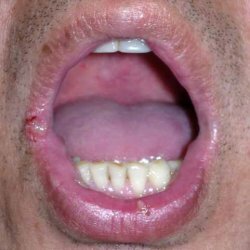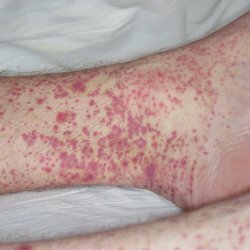Giant cell arteritis: what it is, symptoms and treatment
Content
- What is giant cell arteritis?
- Who has giant cell arteritis?
- Symptoms of giant cell arteritis
- Causes of giant cell arteritis
- Diagnostics
- Blood tests
- X-ray and scan
- Temporal artery biopsy
- What are the treatments for giant cell arteritis?
- Steroid drugs
- What are the side effects of steroid treatment?
- Are there any other drugs used to treat giant cell arteritis?
- Forecast
What is giant cell arteritis?
Giant cell arteritis (also called temporal arteritis or Horton's disease) is a disease that causes pain and swelling in the blood vessels.
Blood vessels are tubes that carry blood throughout the body. Giant cell arteritis affects the arteries, which are the largest of the three types of blood vessels. Arteries carry blood and oxygen from the heart to different parts of the body.
Horton's disease usually affects the arteries in the head and neck.
The condition can cause pain and tenderness in the soft part on the sides of the head between the eyes and ears, known as the temples. When the condition affects this part of the head, it can be called temporal arteritis.
Also, the disease can affect other large arteries and their branches, which draw blood in other parts of the body.
The condition is treatable, usually with steroid pills. If left untreated, the condition can be very serious and cause stroke or blindness.
Giant cell arteritis is one of a group of conditions called vasculitis. The word vasculitis means inflammation in the blood vessels. There are different types of vasculitis that affect different blood vessels.
Who has giant cell arteritis?
The disease is very rare in people under the age of 50. More common in women than men, and more common in people of northern European descent than in people of other races.
Giant cell arteritis is often associated with a condition called polymyalgia rheumatica, which causes muscle pain and stiffness, especially in the shoulders, neck, and thighs. The symptoms of polymyalgia rheumatica can be especially severe in the morning. People often have both polymyalgia rheumatica and giant cell arteritis.
Symptoms of giant cell arteritis

People with arteritis can have a variety of symptoms. Most people have some, but not all of them. The most common symptoms include:
- headaches, often with severe pain and tenderness in the temples of the head - it may be painful to comb your hair or shave. Headaches can occur elsewhere in the head.
- thickening of blood vessels in the temples
- pain in the jaw or tongue when chewing
- severe fatigue, which affects the quality of life
- flu symptomssuch as mild fever
- sweating day or night
- weight loss
- double vision (diplopia)
- rarely - loss of vision, which can occur suddenly. The loss can be partial, but sometimes complete. This is usually temporary in the early stages.
If there are any changes or problems with vision or pain in the jaw while eating, you should see your doctor immediately.
If you cannot get immediate help from your doctor, see an out-of-hours paid doctor or go immediately to the emergency department at your nearest hospital. If left untreated, symptoms can lead to vision loss or stroke..
Read also:Rheumatic arthritis: what is it, causes, symptoms, diagnosis and treatment
Serious problems can usually be avoided with surgical steroid treatment.
Less commonly, the disease can affect other large blood vessels, which can lead to pain when using the muscles in the arms or in the legs while walking.
Rarely, if someone has had giant cell arteritis and polymyalgia rheumatica for a long time, they may develop aneurysms. This is when the walls of the arteries increase in size and can bulge and become weak.
Causes of giant cell arteritis

Scientists do not yet fully know why people get giant cell arteritis.
it autoimmune disease. Those. a condition where the immune system, which is the body's defense system that fights infections, gets confused and attacks healthy tissues in the body.
In people with this disease, the immune system mistakenly attacks healthy arteries.
It is possible that the genes that the child inherited from their parents increases the likelihood of developing the disease. However, if someone has a disease, this does not mean that their children will necessarily get it.
Diagnostics
The diagnosis of the disease will be based on:
- examination by a doctor or specialist and discussion of symptoms;
- blood test results;
- X-ray and scanning (CT, ultrasound);
- biopsy of tissue showing if there is inflammation in the walls of the temporal artery.
Blood tests
Blood tests can be done to check for signs of inflammation. These tests can be used to diagnose a disease.
They will also be repeated over time to check that inflammation is under control. Blood tests can also be used to look for other possible causes of symptoms.
X-ray and scan
The patient may be asked to take a chest x-ray to rule out other medical conditions.
Another study that could be offered is computed tomography (CT). It can help diagnose giant cell arteritis and see if there are any complications. CT scans create detailed images of what is happening inside the body using many X-rays.
The doctor may also request an ultrasound scan of the arteries around the temples and armpits to confirm the diagnosis.
Ultrasound scans use sound waves to examine and create images inside the body. They can show what's going on in tendons, blood vessels, joints, and even organs. In the event of illness, these scan tools can be helpful because they can detect swelling in blood vessels.
Temporal artery biopsy
Sometimes a temporal artery biopsy may be done.
A biopsy is when a small piece of skin or tissue is taken from a part of the body and examined under a microscope. In this case, tissue is taken from the temporal artery of the head.
The biopsy is done by a surgeon, but this is an examination, not a treatment. Before the procedure, the doctor will explain all the risks and benefits, and will make anesthesia.
This biopsy can be done to confirm the diagnosis even if treatment is started. The biopsy will show how serious the patient's condition is.
After the biopsy, there will be wound about 3-4 cm longclose to the hairline. The wound will be covered with a bandage until your next doctor's appointment in about a week, but you should be able to wash your hair thoroughly. When the anesthesia wears off, pain relievers such as paracetamol may be needed.
Read also:Polymyalgia rheumatica
As with any surgical procedure, watch for signs of bleeding and infection (spreading redness, persistent discharge).
Very rarely, the procedure can cause temporary or permanent damage to the nerves, which can lead to numbness or drooping of the eyebrows. In patients with narrowing of the arteries in the neck, known as carotid artery disease, the risk of stroke may be very small.
If you have any concerns about the risks, you should discuss them with your doctor in advance.
What are the treatments for giant cell arteritis?
Steroid drugs

Although there is currently no cure for giant cell arteritis, treatment with steroid (corticosteroid) drugs is very effective and usually begins to work after a few days. Prednisolone Is the most commonly used steroid drug.
Steroids slow down the immune system and reduce inflammation in the blood vessels.
Because there is a risk of vision loss or stroke, it is important to start treatment with corticosteroids immediately. If your doctor suspects you have arteritis, they may prescribe a high dose of steroids until the diagnosis is confirmed.
For the treatment of giant cell arteritis, usually 40 to 60 mg of steroid tablets are given daily. This dose is usually continued for three to four weeks.
If the patient then feels well and blood tests show that the condition has improved, the doctor will begin to reduce the dose. At this stage, the specialist will regularly visit the patient to check his general well-being.
If visual symptoms or pain in the jaw or tongue appear while eating, urgent therapy with intravenous steroids may be required.
It usually takes one to three years to completely stop corticosteroids. Most of this time, the patient takes low doses of the drug. It is not always possible to completely stop taking steroids, and some people need to take low doses for a long time or for life.
You should not suddenly stop taking steroid pills or change the dose unless recommended by your doctor, even if the symptoms have completely disappeared. This is because the body stops producing its own steroid called cortisol, so it will take some time for the normal production of natural steroids to resume.
If the inflammation in the blood vessels returns, this is called a relapse and you may need to increase your steroid dose to deal with it. Relapse is most common during the first 18 months of treatment.
What are the side effects of steroid treatment?
As with many medicines, there are some side effects that can occur with steroid treatment. However, giant cell arteritis is a potentially very serious condition. The benefits of successful steroid treatment for sick people far outweigh the risks of side effects from the drug.
An initial high dose of corticosteroids to control the condition, followed by an ongoing low dose to keep the disease under control, can sometimes cause the following side effects:
- changes in the appearance of the face and body;
- redness of the face;
- lack of sleep;
- upset stomach or abdominal pain;
- weight gain;
- dizziness or weakness;
- difficulty concentrating;
- change of mood.
Drugs called proton pump inhibitors can reduce your risk of indigestion. They do this by decreasing the amount of acid produced naturally in the stomach.
Read also:Sharpe syndrome: what it is, causes, symptoms, diagnosis and treatment
If you take steroids for a long time, other side effects can occur, including:
- osteoporosis - a condition in which bones become thinner and easier to break;
- minor bruises, stretch marks and thinning of the skin;
- muscle weakness;
- cataract - a condition in which cloudy spots appear on the lens of one or both eyes;
- glaucoma - a condition in which the optic nerve of the eye is damaged;
- diabetes - a disease in which the level of sugar in the blood rises;
- high blood pressure (arterial hypertension).
Regular check-ups will help identify any side effects so that they can be quickly addressed.
If you have been using steroids for more than three months, you may need treatment to prevent thinning of your bones, including:
- calcium and vitamin D supplements;
- bisphosphonates are drugs that slow down bone loss.
Since steroids decrease the activity of the immune system, infections can develop and they can be serious. For example, chickenpox and shingles may be more serious in people taking steroids.
See your doctor if you have not had chickenpox or have come into contact with someone with chickenpox or shinglesas treatment may be required antiviral drugs.
Are there any other drugs used to treat giant cell arteritis?
Corticosteroids are the first line drugs to control giant cell arteritis and prevent any serious complications. There is currently no other first-line alternative therapy.
There are times when your doctor may suggest additional medications to help reduce your steroid dose, this can happen if:
- symptoms return, otherwise they recur;
- symptoms do not improve despite steroid treatment;
- need steroid treatment for a long time.
Alternative treatments may include taking conventional disease-modifying antirheumatic drugs (BMARP), including:
- methotrexate;
- leflunomide;
- azathioprine;
- mycophenolate mofetil.
These drugs slow down the immune system that causes malfunctioning in people with autoimmune diseases.
There are also several other medications available, called immunosuppressants. These drugs target key cells in the immune system to stop inflammation.
Immunosuppressive treatment includes medications such as tocilizumab. Tocilizumab is used primarily for the treatment of people with recurrent large vessel vasculitis. A drug may also be prescribed if other treatments fail.
Forecast
With prompt adequate therapy, complete recovery is observed. Arteritis symptoms improve within a few days after treatment. Corticosteroids can usually be lowered within the first 4-6 weeks and eventually stopped. The decline in neuro-ophthalmic complications in recent years reflects improved recognition and treatment; blindness is now a rare complication.
Although the overall course of the disease is progressive improvement and possible complete cure, the clinical course is highly variable. The average duration of treatment is 2 years; However, some patients require treatment for 5 years or more.



